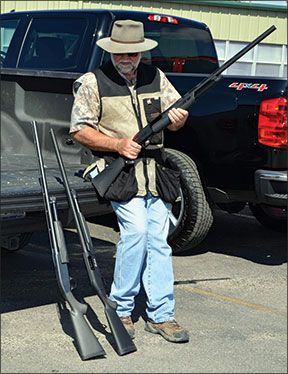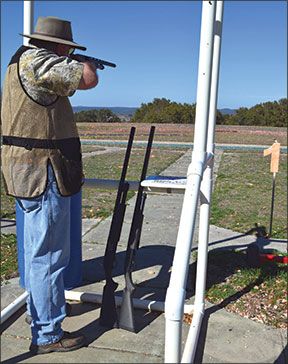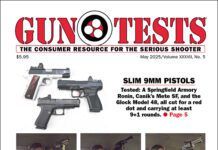While there may be some shooters who might question the claim that the Winchester Model 12 set the standard for pump-action shotguns, no one can dispute the popularity of the smoke pole introduced in August 1912 and discontinued in May 1964. There are still many, many of the old Model 12s in use today – truly a testament to the craftsmanship of the fine firearm.

The Model 12 was discontinued because, with its forged and machined steel parts, Winchester deemed the shotgun was too expensive to produce at a competitive price. Filling in the void among pump-action fans was the less expensive Remington Model 870, which is still produced today and also has a huge following among shooters both young and old. Both the Model 1200 and Model 1300 were introduced over the years as Winchester pump-action offerings, but never gained the popularity of the Model 12.
Fast forward to 2013 when the Winchester SXP came on the shooting scene as what is billed as a shotgun capable of the fastest follow-up shots of any pump on the market – three shots in less than half a second.
We decided to get some hands-on time with the Winchester SXP and compare it to a couple of pumps it competes with in the field – a Weatherby Model PA-08 and a Browning BPS Stalker.
Shooters who favor pump-action shotguns, whether for nostalgia or economic reasons, generally agree that their smoke pole will not be as balanced or handle as well as high-end over-and-unders or semi-automatics. The pumps are workhorse tools, but can be evaluated on more than just their ability to send lead downrange in a safe and effective manner.
Our test session focused on function, but also took into account balance and appearance in determining which firearm we favored. To give us a good sense of performance, we checked out the trio on the patterning board using both lead target loads and steel waterfowl loads. For handling clay targets and birds, we patterned Federal Game & Target 23⁄4-inch loads with 11⁄8 ounces of No. 8 shot and an average muzzle velocity of 1200 fps and Winchester AA Xtra-Lite Target 23⁄4-inch loads with 1 ounce of No. 71⁄2 shot and an average muzzle velocity of 1180 fps. Our steel loads in the test were Winchesters new Elite Blind Side 3-inch loads with 13⁄8 ounces of No. 2 shot and an average muzzle velocity of 1400 fps. Here are our findings:
Winchester Super X PumpBlack Shadow No. 5122519212 Gauge, $430
With its new-age textured forearm and stock, high-strength alloy receiver, and Inflex Technology recoil pad, the Winchester SXP would never be mistaken for its ancient ancestor, the Model 12. That being said, its heft and feel, plus its lightning-fast slide action, does do honor to the venerable pump that many considered to be the finest single-barrel shotgun ever made.
Red stripes here and there, in addition to the Winchester logos, provide a little contrast to the all-black shotgun for those who look for a little fashion in their shooting tool.
As noted in the promotional material, the action of the pump is incredibly fast and smooth. Working the action on an empty chamber was very pleasant, with none of the stiffness normally found in a shotgun right out of the box. On the range, the pump lived up to its billing, wherein second and third shots were handled in a manner that reminded some of our older test team members of their younger years wielding a Model 12 – high praise indeed.
The shotgun was the longest of the three models, measuring 49 inches from the back of the recoil pad to the end of the barrel. The length of pull was the shortest of the models, with its 13.75-inch length of pull comfortable for all of our test group. The drop at the comb was 1.4 inches and the drop at the heel was 2 inches. These dimensions fit like a glove for most of the test group.
We were slightly disappointed with the trigger pull weight of 8 pounds, which is heavier than most shotgun shooters favor. A little gunsmith tweaking would be recommended to allow for smoother handling of targets and birds.

Our trip to the patterning range was enlightening and surprising, as the Winchester produced a nearly perfect 50-50 pattern with the target loads and about a 55-45 pattern with the steel shot. Even the heavier waterfowl loads did not cause much shoulder trauma when fired in the 7-pound shotgun.
Clay targets were handled with comfort and ease during our field tests, and we encountered no problems with any of the ammunition. Once again, we were very pleased with the way the shotgun cycled the second round on clays and the third shot when putting patterns on paper.
Browning BPS StalkerNo. 012212304 12 Gauge, $700
It has been about four years since GT put a Browning BPS Stalker through its paces in a test against another slide-actions, and this match-up seemed like a good time for a revisit.
One of our first observations was that Browning is a little more muzzle heavy than the other models. On the plus side, the lighter felt recoil and swing smoothness were noted by our team. On the negative side, the Browning was a little more difficult to manage by our teams smaller members, although they quickly made their adjustments and did not consider the heft to be a major factor.
Once we passed the minor adjustment phase, we found the Browning was quite comfortable to handle and was very easy to shoot. While not as fast as the Winchester, cycling shells through the Browning was accomplished with ease. We experienced no hangups with any of the ammunition.
The overall length of the Browning was 48.5 inches, with a length of pull of 14.25 inches. Featuring a drop at the comb of 1.5 inches and a drop at the heel of 2.5 inches, we liked the fit and feel of the composite stock.
Featuring an ambidextrous safety on the top of the receiver, in combination with a bottom-ejection system, the Browning can be fired by both right-handed shooters and lefties without any adjustment. The tang safety is also very simple to operate, even when wearing gloves, giving the Browning an advantage in the safe-operation category.
Another plus for the Browning was the trigger pull, with the break occurring at about 6 pounds, about two pounds lighter than either of the other test shotguns. While trigger-pull weight is not as important factor with shotgunners as it is with rifle and pistol shooters, a smooth, light touch-off does improve performance on the range and in the field.
On the clay-target range, we found that the Browning performed very well and glided through targets with ease. About a pound heavier than either of the other pumps, the Browning did its part in smoothing out the swing of the shooter – when we missed a target, it was not the shotguns fault.
The patterning part of the test was conducted on a pattern board set up 30 yards downrange and we used a modified choke – just like with the other two shotguns in the trio. The Browning produced a very respectable 50-50 pattern, with the pellet spread evenly distributed across the paper and no gaps in the coverage. The solid pattern was demonstrated often on the clay target range, where targets were smacked with authority.
Putting the steel loads to the test on paper targets, we found the Browning produced about a 60-40 spread with the Winchester Elite Blind Side shells that are shaped like a cube to allow for denser patterns. The upper part of the paper pattern was nearly solid — a good killing group capable of downing waterfowl with effectiveness.
Weatherby Model PA-08Synthetic No. S1228PGM12 Gauge, $399
Right out of the box, there were no standout features of the Weatherby PA-08, which is the perfect example of a standard, synthetic pump-action field shotgun. If that is what a shooter is looking for, the Weatherby fits the bill. Working the action by depressing the lever in front of the trigger guard, we found it to be quite stiff and surprisingly louder than the other two models. Even after cycling about a case of shells through the Weatherby, there was no appreciable change in the stiffness.
The Weatherby was the shortest of the trio, measuring 48 inches, with a length of pull of 14 inches. The drop at the comb was 1.5 inches and the drop at the heel was 2.25 inches, providing an acceptable fit for our shooting team. The balance of the shotgun seemed to be just a little bit off, but not enough to cause any major handling problems.
The patterning performance of the Weatherby was less than impressive, with the target loads producing a 60-40 pattern with the modified choke at 30 yards. We also noted several significant holes in the group that would have allowed a target or bird to escape unscathed.
The Weatherbys patterning performance resulted in predictable results on the clay target field, with hit targets not being smashed like with the Winchester and Browning. Chipped targets still count as a hit on the score sheet, but dont instill much confidence.
When we put the Weatherby to the test with the steel Winchester Blind Side loads, the average pattern was a 70-30 spread, with most of the hits above the center of the target. As with the lead shot, there were significant holes in the pattern.
Another problem encountered with the Weatherby, probably a factor of the stiff action, was several hang-ups when a second round failed to load or was hard to chamber. Perhaps after extended usage, this problem will work itself out, but both of the other shotguns smoothly handling the loads right out of the box.
The trigger pull on the Weatherby was a stiff 8.5 pounds and may have been another factor in the way the shotgun performed on clays. Having to use extra force to touch off a shot can cause a shooter to pull off a target. A trip to a gunsmith might be necessary to lighten the pull and make the shotgun a better shooter.
In addition, recoil from all the loads was considered more excessive than with the other two shotguns in the test, particularly with the Winchester Blind Side loads. There was quite a rap with the 3-inch shells that was not satisfactorily handled by the Weatherbys thick, hard-rubber recoil pad.
Our Team Said
Winchester Model Super X Pump Black Shadow No. 51225192 12 Gauge, $430. It was hard for us to find any fault with this latest Winchester Model SXP Black Shadow pump-action shotgun that follows in the huge footsteps of the legendary Model 12. The SXP swings well, does not produce shoulder shock even with heavy loads, and shucks spent rounds like lightning. Time will tell if the SXP has the lasting power of the Model 12, but it seems to be starting on a good track.
Browning BPS Stalker No. 012212304 12 Gauge, $700. Other than having to adjust to the shotguns additional heft, the Browning shone during our testing, and we found particular favor in its ambidextrous safety and bottom-ejection feature. The price will make this a distant second choice for many shooters, however.
Weatherby Model PA-08 Synthetic No. S1228PGM 12 Gauge, $399. Its appearance, balance, or handling ability do not set this shotgun apart from most other bargain-priced synthetic versions of field firearms. Patterning performance was the weakest of the three, and we did experience some shell-shucking problems with the stiff action.
Written and photographed byRalph Winingham, using evaluations from Gun Tests team testers. GT




























